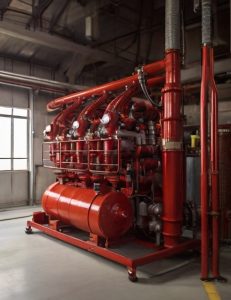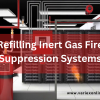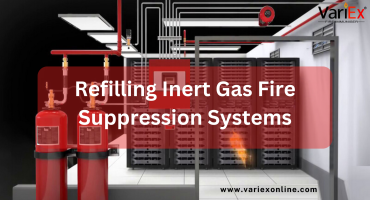![]()
Fire Immuniser
+91-7829629111
Email: info@variex.in
Varistor Technologies Pvt. Ltd.
Block-1, First Floor, Ardente Office One, Hoodi Circle, ITPL Main Road, Bengaluru, Karnataka 560048, IN
Fixed Foam Fire Fighting System Regulations
Fixed foam fire fighting systems are critical for combating flammable liquid fires in various industries, including petrochemical, oil and gas, and chemical processing. Understanding the regulations governing these systems is essential for ensuring compliance and maximizing safety. This guide explores the key regulations and standards applicable to fixed foam fire fighting systems.
1. NFPA 11: Standard for Low-, Medium-, and High-Expansion Foam
- The National Fire Protection Association (NFPA) 11 standard provides guidelines for the design, installation, operation, testing, and maintenance of fixed foam fire fighting systems.
- It covers various aspects, including foam concentrate storage, proportioning, discharge devices, and system components.
2. NFPA 16: Standard for the Installation of Foam-Water Sprinkler and Foam-Water Spray Systems
- NFPA 16 outlines requirements for the design, installation, and maintenance of foam-water sprinkler and foam-water spray systems used in fire protection applications.
- The standard addresses system design, component selection, hydraulic calculations, and testing procedures.
3. International Fire Code (IFC) and National Fire Code (NFC)
- The International Fire Code (IFC) and National Fire Code (NFC) provide regulations related to fire protection and prevention, including the installation and maintenance of fixed foam fire fighting systems.
- These codes may adopt NFPA standards or include specific requirements for foam systems based on local jurisdictional needs.
4. OSHA Regulations
- The Occupational Safety and Health Administration (OSHA) sets workplace safety regulations that may impact the design, installation, and operation of fixed foam fire fighting systems.
- OSHA standards address employee safety, hazard communication, and emergency response procedures, which can influence foam system requirements.
5. Environmental Regulations
- Environmental regulations, such as those enforced by the Environmental Protection Agency (EPA), may govern the use and discharge of foam concentrates, especially those containing environmentally harmful substances.
- Compliance with regulations regarding foam concentrate storage, handling, and disposal is essential to minimize environmental impact.
6. Manufacturer Specifications and Recommendations
- Manufacturers of foam concentrates, proportioning systems, and discharge devices provide specific guidelines and recommendations for the installation, operation, and maintenance of their products.
- Following manufacturer specifications ensures optimal system performance and reliability.
7. Local Jurisdictional Requirements
- Local fire departments, building departments, and authorities having jurisdiction (AHJs) may impose additional regulations or requirements specific to their jurisdiction.
- Building permits, inspections, and approvals may be necessary to ensure compliance with local regulations.
8. Training and Certification Requirements
- Regulations may also address training and certification requirements for personnel responsible for operating and maintaining fixed foam fire fighting systems.
- Proper training ensures that personnel are competent in system operation, maintenance, and emergency response procedures.
Conclusion
Compliance with regulations and standards governing fixed foam fire fighting systems is crucial for ensuring effective fire protection and safety in industrial facilities. By understanding and adhering to these regulations, facility owners and operators can mitigate risks, protect personnel and property, and maintain regulatory compliance. Regular updates and staying informed about evolving regulations are essential to ensure continued compliance and optimal system performance.
Frequently Asked Questions
1. What are fixed foam fire fighting systems, and why are regulations important?
Fixed foam fire fighting systems are designed to combat flammable liquid fires by applying foam to suppress the fire. Regulations are crucial to ensure these systems are designed, installed, and maintained correctly to maximize safety and effectiveness.
2. Which organizations or standards govern fixed foam fire fighting systems?
Organizations such as the National Fire Protection Association (NFPA) develop standards like NFPA 11 and NFPA 16 specifically for foam fire fighting systems. Additionally, regulatory bodies like OSHA and local jurisdictions enforce regulations related to workplace safety and fire protection.
3. What does NFPA 11 cover, and how does it relate to fixed foam fire fighting systems?
NFPA 11 provides guidelines for the design, installation, operation, testing, and maintenance of low-, medium-, and high-expansion foam systems. It addresses various aspects, including foam concentrate storage, proportioning, and discharge devices.
4. Are there specific regulations for foam concentrate handling and environmental impact?
Yes, environmental regulations enforced by agencies like the Environmental Protection Agency (EPA) may govern the use, storage, and disposal of foam concentrates, especially those containing environmentally harmful substances. Compliance with these regulations minimizes environmental impact.
5. Do local jurisdictions have their own regulations for fixed foam fire fighting systems?
Yes, local fire departments, building departments, and authorities having jurisdiction (AHJs) may impose additional regulations or requirements specific to their jurisdiction. This may include permitting, inspections, and approvals.
6. Are there training requirements for personnel operating fixed foam fire fighting systems?
Yes, regulations may address training and certification requirements for personnel responsible for operating and maintaining foam fire fighting systems. Proper training ensures personnel are competent in system operation, maintenance, and emergency response procedures.
7. How often should fixed foam fire fighting systems be inspected to ensure compliance?
Fixed foam fire fighting systems should be inspected regularly according to manufacturer recommendations, regulatory requirements, and industry best practices. Typically, inspections are conducted annually or as specified by applicable standards and regulations.
8. What should I do if I have questions about regulations governing fixed foam fire fighting systems?
If you have questions about regulations, consult with knowledgeable professionals, such as fire protection engineers, regulatory compliance specialists, or local fire officials. They can provide guidance and clarification on specific requirements applicable to your situation.
Final Say
We at VariEx.in or Variexonline.com have mastered the art of designing, installing, inspecting, and fixing automatic sprinkler systems with the help of our in-house team, which is capable of delivering the fire sprinkler services you need, whether large or small and at affordable cost.
To schedule a fire sprinkler installation, or you think our services could benefit your commercial property, contact us online or give us a call at, 7829629111










